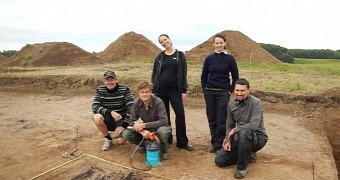Not too long ago, a previously undocumented Viking fortress was discovered in Denmark by archaeologists who used laser technology to map the landscape in unprecedented detail and who noticed a peculiar circular outline emerging from the ground.
At a closer look, this perfectly circular outline turned out to be the remains of the Viking fortress. According to specialist Nanna Holm with The Danish Castle Center and Aarhus University researcher Søren Sindbæk, the settlement is strikingly similar to other Viking establishments.
The fortress' anatomy
Information shared with the public by the scientists behind this archaeological find says that this circular Viking fortress measures about 145 meters (approximately 475 feet) across. This makes it a fairly impressive structure, be it only size-wise.
By the looks of it, Vikings had a total of four gates to pick and choose from when wishing to enter or exit this establishment. As detailed by specialists Nanna Holm and Søren Sindbæk, each of these massive gates is facing another cardinal point.
Up until now, researchers have only had the chance to closely examine two of the fortress' gates. Of these, the one facing north was found to have charred oak posts. Hence, it was concluded that the establishment likely witnessed several fights in its heydays.
So, how old is this Viking establishment?
For the time being, the archaeologists exploring this site cannot say for sure when the fortress was built. However, they expect that charred oak samples taken from the establishment's north-facing gate will help them pin down the monument's age.
“The burned wood in the gates will makes it possible to determine the age by means radiocarbon dating and dendrochronology,” researcher Nanna Holm explained in a statement, as cited by Phys Org. “The samples have been sent, and we will be eager to hear the results,” she added.
What does this discovery tell us about Vikings?
Thanks to Hollywood, most people are quite convinced that Viking spent their entire lives cruising seas and oceans, and raging war on whoever was unlucky enough to cross paths with them or spark their anger. The discovery of this monument indicates that, on the contrary, they too enjoyed life on land.
As Nanna Holm put it, “The Vikings have a reputation as a berserker and pirates. It comes as a surprise to many that they were also capable of building magnificent fortresses.” “This is a unique monument, which will be of great cultural value for Denmark,” added Keld Møller Hansen, director of the Museum of Southeast Denmark.

 14 DAY TRIAL //
14 DAY TRIAL //